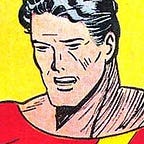A haunted typewriter reviews the first issue of horror comics anthology ‘Razorblades’
Among the many curiosities of the derelict Elridge mansion is Buchanan Elridge’s old typewriter. It was not uncommon for Elridge’s neighbors to hear the young writer typing on the Underwood №5 as he crafted lurid horror fiction for various pulp magazines. Elridge’s more famous contemporaries, Howard and Lovecraft, praised his stories; he would likely have achieved greater literary acclaim, had he not been murdered in 1929. But on most nights, a passerby can still hear the sound of typing coming from the mansion’s third floor study, keys tapping words onto ectoplasmic paper, perhaps crafting a novel, a short story, or a review…
The catharsis provided by horror fiction is a good tonic for human anxiety, and writer James Tynion IV and his collaborators offer readers piquant medicine for these uneasy times with their disquieting new horror anthology comic Razorblades. Published by Tiny Onion Studios, Razorblades showcases the disturbing work of modern creators, featuring provocative short comics and prose pieces, its very title intentionally evoking, as the publisher states, “small, sharp things that can cut you.”
Conceived by Tynion and writer/editor Steve Foxe as a quarterly creator-owned horror anthology, Razorblades presents horror features that are deliberately modern, eschewing, as Tynion notes in his introduction, evocations of old horror tropes. There are no conventional werewolves, zombies, or vampires in the first issue for readers to comfortably identify; readers explore new horror territory that is both experimental and disorienting. Even its distribution method is unconventional; rather than choosing crowdfunding or print distribution to comics shops, Tiny Onion Studios offers the 75-page comic digitally, with a pay-what-you-want pricing model at the site readrazorblades.com, with a limited print run of the first issue available.
The issue’s first and last stories — “The Washing Machine” by Tynion and artist Andy Belanger (with letterer Serge LaPointe) and “A Dream of Time” by writer Ram V and artist John J. Pearson (with letterer Aditya Bidikar), respectively — share a thematic connection; both stories invoke a sense of repetitive, inescapable destructive cycles. In “The Washing Machine,” a disturbed man is trapped by his guilt and fear, the tension of the story deftly captured by Belanger’s gory visuals and crammed panels…
“Aaah!” The typewriter paused as the screams began, coming from two trespassing teenagers in the downstairs foyer who had looked at a dusty mirror; in the reflection, they had seen a naked, skinless giant with long arms and sharp teeth standing behind them. When the screams stopped, the typing resumed…
… In “A Dream of Time,” a modern man dreams of an ancient Mayan priest writing prophecies of the end of the world on a stone tablet, both the man and the priest seemingly disappointed that such an end to their futile endeavors never arrives. Pearson’s artwork is lush and gorgeous, depicting modern horrors and ancient deities in beautiful juxtaposition.
Arguably the comic’s most striking commentary on modern society is “Local Heroes” by writer Marguerite Bennett and artist Wertha Dell’Edera (with colorist Emilio Lecce and letterer Hassan Otsmane-Elhaou). A child is abducted and a rescue attempted, but the societal prejudices regarding race and gender that ensue are just as frightening as the abduction. Lecce’s bright colors highlight the dark truths of the story, and Dell’Edera’s art displays action and anguish in equal measure.
Artist Trung Nguyen’s “Baby Blue” is both beautiful and discomfiting, inviting the reader to imagine what has transpired before the story opens, and what comes afterward.
Downstairs, a college student sobbed. He had come into the mansion two days ago looking for his lost cat, but the ruin was bigger than he thought, with one door leading to another, one hall leading to others, a maze he could not escape. Dehydrated and exhausted, he had just found his cat’s decomposing body, next to the skeletons of a dozen humans and their pets. The typing continued…
In “She’s Got It,” by writer Lonnie Nadler and artist Jenna Cha (with letterer Otsmane-Elhaou), a seemingly banal social occasion becomes increasingly surreal and grotesque, with Cha’s artwork providing captivating body horror for a reader’s eyes to digest.
Artist Brian Level’s one-page illustration, “Nothing to Get Hung About,” mixes innocence and sex in a frightening, titillating combination.
In “Dead Means Dead” from writer Foxe and artist Michael Dialynas, with letterer Otsmane-Elhaou, a medical examiner faces her fears about being buried alive, with Dialynas rendering gross visuals with an intense focus on the protagonist’s terror.
Prose pieces include Tynion’s interview with acclaimed comics writer Scott Snyder regarding Snyder’s work and the craft of writing horror, and in “Mid-Season Slump” from writer Danny Lore, with an illustration by Aaron Campbell, a celebrity occult investigator is haunted by the compromises he has made on the way to fame.
The girl from another world spoke to her companion, the ghost of Alfred Hitchcock. The two gently argued about where they had arrived, and next steps. They had traveled under duress to this world and this mansion, as they had before to other worlds and other mansions, via a special skeleton key and a strange word that enchanted any door into a magic portal. But they should have closed the door behind them; a vampire Salvador Dalí had continued its hunt, and now lunged at the girl. Tap tap tap…
Other comics pieces and illustrations can be found in the first issue of Razorblades; the comic’s large page count, excellent features, and pay-what-you-want price make it an enticing book for readers who want to explore stories that will cut their perceptions of horror, and haunt them long after they finish reading the comic.
NOTE: As stated above, digital copies of Razorblades are currently available — at a pay-what-you-want price — at the site readrazorblades.com.
The text and images above are the property of their respective owner(s), and are presented here for nonprofit, educational, and review purposes only under the fair use doctrine of the copyright laws of the United States of America.
